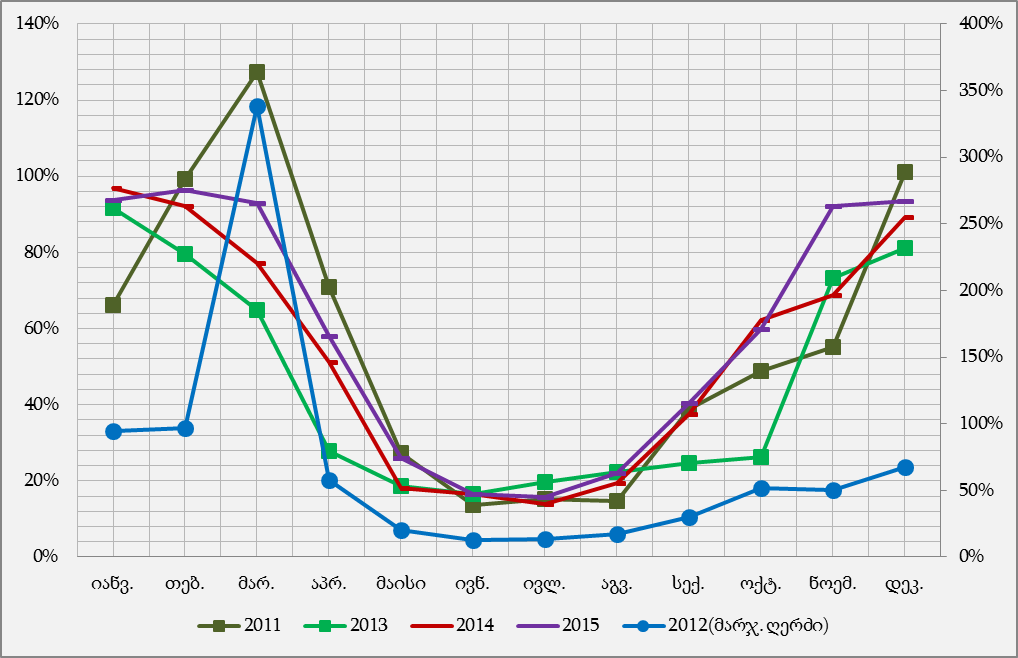During his speech at the Parliament of Georgia, the President of Georgia, Giorgi Margvelashvili, stated that the employment figures in Georgia are worrying because a large share of those employed is working in the public sector.
FactCheck took interest in this issue.
The latest employment data from the National Statistics Office of Georgia describe the situation as it was in 2014 and show that the rate of unemployment was 12.4% at the time. This is 2.2% less than it was in 2013. According to the methodology used by the National Statistics Office, persons who are self-employed (those who work in their own households or enterprises) are also included in the larger body of those employed. A large share of self-employed persons in Georgia work in the field of agriculture where their income is low and their social condition is dire. About 60% of all employed persons are self-employed. In the European Union, the percentage of those self-employed among the larger body of those employed is only around 16%.
Despite the fact that the number of employed persons in Georgia has increased, the decrease in the number of economically active people (labour force) has also had a significant influence upon the drop in unemployment. In 2014, the number of unemployed persons decreased by 59.1 thousand as compared to 2012 whilst the number of employed persons increased by 21.2 thousand. The number of those economically active dropped by 38,000 (they are not included in the number of employed persons or in the number of those unemployed). Hence, the drop in unemployment (65%) is mainly due to the decrease in the number of economically active persons rather than the growth of the number of those employed.
The share of those employed in the public sector in the overall employment statistics varies from country to country. This share is the highest in the Scandinavian countries (from 28% to 34%) whilst it is at its lowest in Japan and South Korea (7.9% and 7.6%, respectively). The share of people employed in the public sector is an average of 21% in the member states of the Organisation for Economic Co-operation and Development (OECD). If we exclude those persons who are self-employed, the share of those employed in the public sector is about 24.5% in developed countries.
FactCheck requested statistics from the National Statistics Office of Georgia vis-à-vis persons hired by the state for positions within the public sector. According to the data given to us, a total of 251,000 persons were employed in the public sector in 2014 which was about 36.2% of those hired throughout the country whilst this share was only 14.3% in regard to overall employment (including those self-employed). It should also be pointed out that the number of those working in the public sector in 2014 was 22.4 thousand lower than it was in 2012.
The overall distribution of employed persons in 2014 looked like this:
Chart 1: Distribution of Employed Persons by Occupation
 Source: National Statistics Office of Georgia
Conclusion
According to the information of the National Statistics Office of Georgia, unemployment was about 15% in 2012 whilst it had dropped to 12.4% in 2014. The decrease in the number of economically active persons had a significant influence upon the drop in unemployment. Self-employed persons still constitute the majority of those employed (60%). Hence, the fact that the situation in terms of unemployment is dire is a true statement.
As for the number of those employed in the public sector, a total of 251.2 thousand people were employed in the public sector in 2014 which was 36.3% of those employed countrywide. If we exclude those who are self-employed, the share of those employed in the public sector is about 24.5% in developed countries.
FactCheck concludes that Giorgi Margvelashvili’s statement is MOSTLY TRUE.
Source: National Statistics Office of Georgia
Conclusion
According to the information of the National Statistics Office of Georgia, unemployment was about 15% in 2012 whilst it had dropped to 12.4% in 2014. The decrease in the number of economically active persons had a significant influence upon the drop in unemployment. Self-employed persons still constitute the majority of those employed (60%). Hence, the fact that the situation in terms of unemployment is dire is a true statement.
As for the number of those employed in the public sector, a total of 251.2 thousand people were employed in the public sector in 2014 which was 36.3% of those employed countrywide. If we exclude those who are self-employed, the share of those employed in the public sector is about 24.5% in developed countries.
FactCheck concludes that Giorgi Margvelashvili’s statement is MOSTLY TRUE.
 Source: National Statistics Office of Georgia
Conclusion
According to the information of the National Statistics Office of Georgia, unemployment was about 15% in 2012 whilst it had dropped to 12.4% in 2014. The decrease in the number of economically active persons had a significant influence upon the drop in unemployment. Self-employed persons still constitute the majority of those employed (60%). Hence, the fact that the situation in terms of unemployment is dire is a true statement.
As for the number of those employed in the public sector, a total of 251.2 thousand people were employed in the public sector in 2014 which was 36.3% of those employed countrywide. If we exclude those who are self-employed, the share of those employed in the public sector is about 24.5% in developed countries.
FactCheck concludes that Giorgi Margvelashvili’s statement is MOSTLY TRUE.
Source: National Statistics Office of Georgia
Conclusion
According to the information of the National Statistics Office of Georgia, unemployment was about 15% in 2012 whilst it had dropped to 12.4% in 2014. The decrease in the number of economically active persons had a significant influence upon the drop in unemployment. Self-employed persons still constitute the majority of those employed (60%). Hence, the fact that the situation in terms of unemployment is dire is a true statement.
As for the number of those employed in the public sector, a total of 251.2 thousand people were employed in the public sector in 2014 which was 36.3% of those employed countrywide. If we exclude those who are self-employed, the share of those employed in the public sector is about 24.5% in developed countries.
FactCheck concludes that Giorgi Margvelashvili’s statement is MOSTLY TRUE.
Tags:







